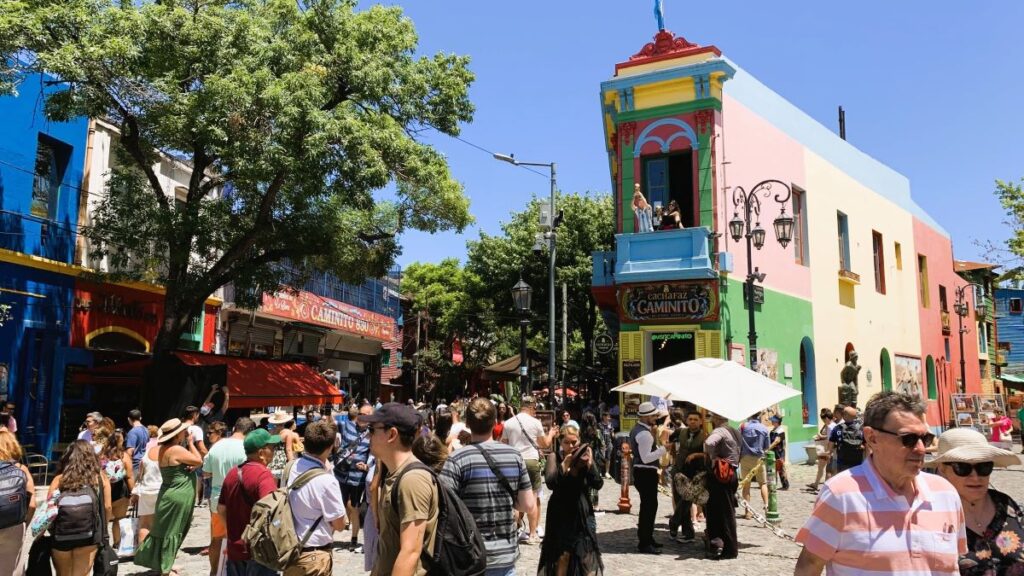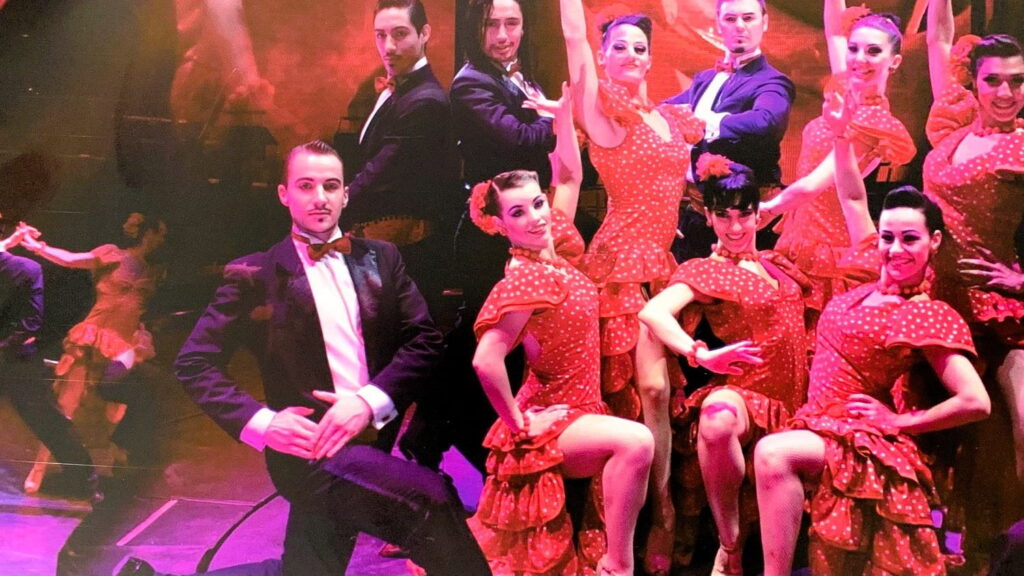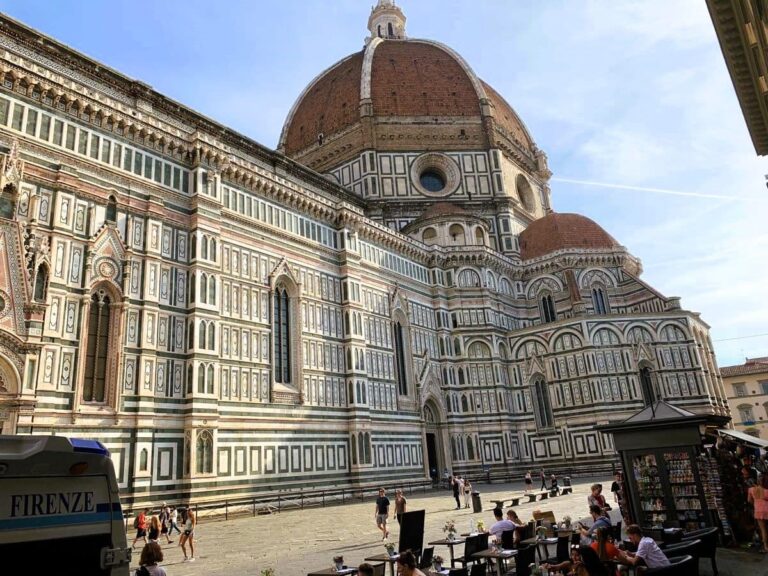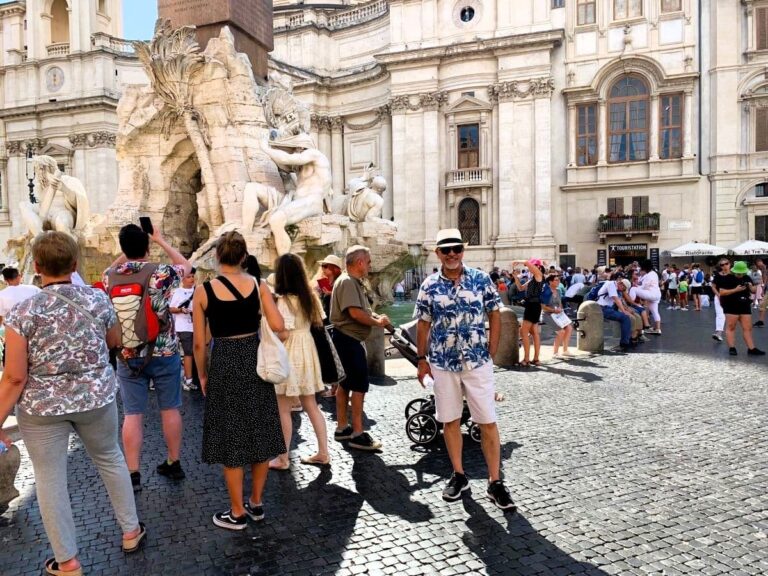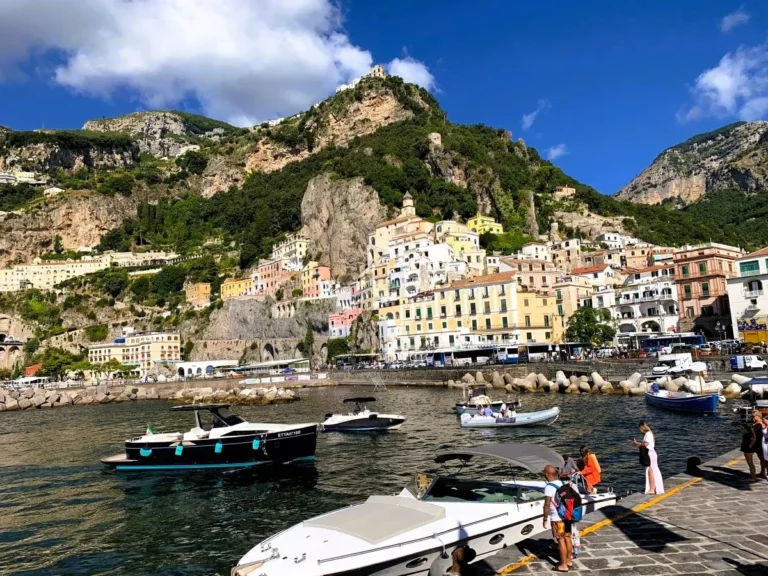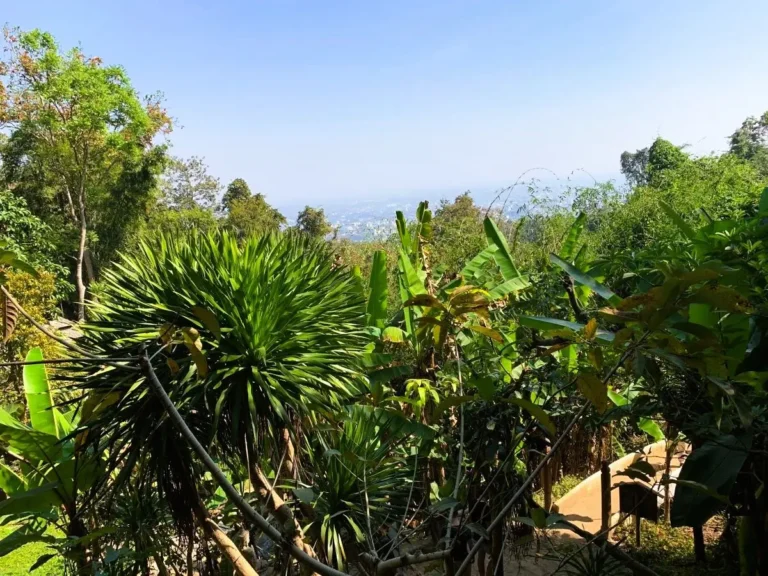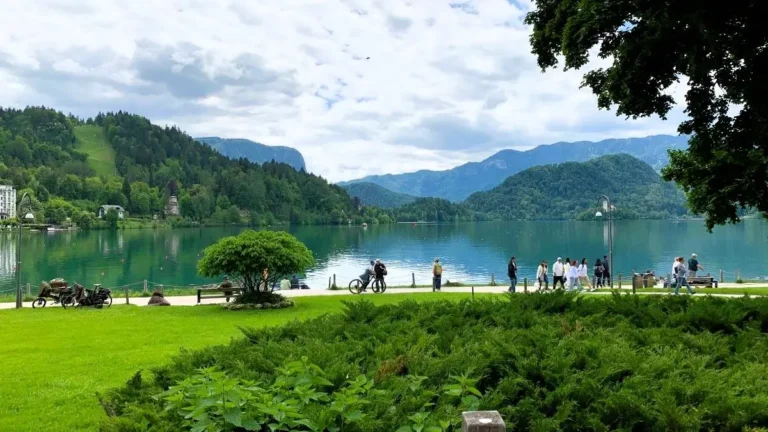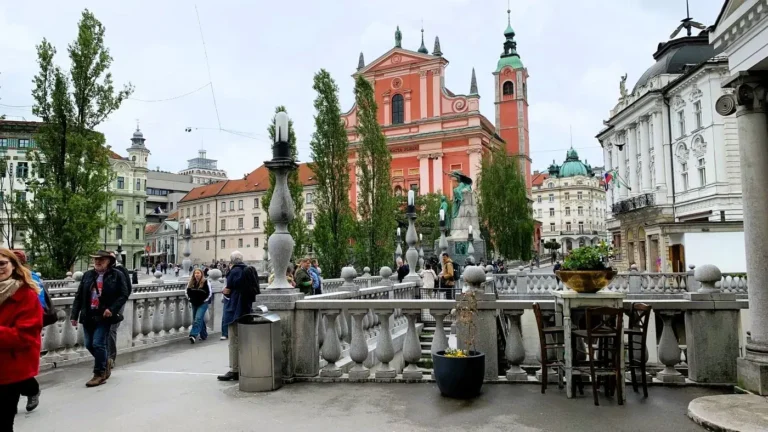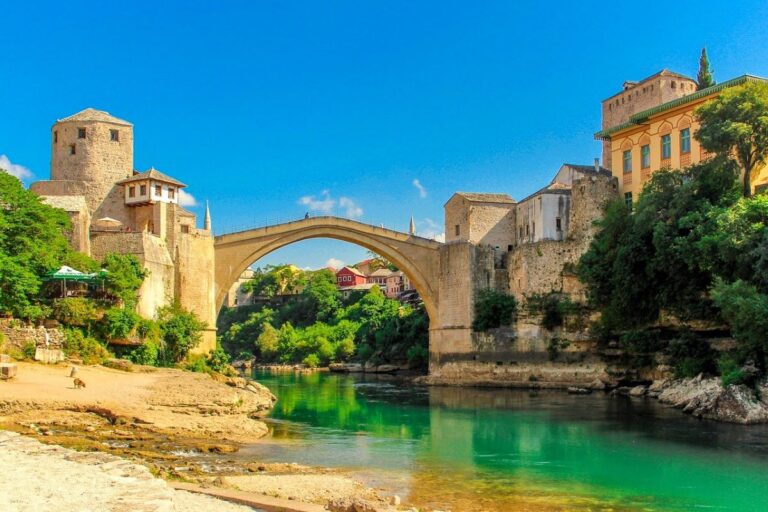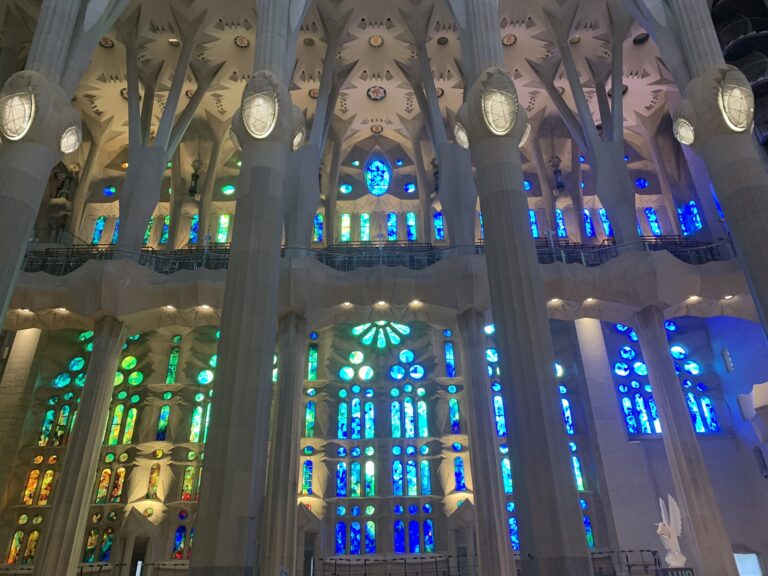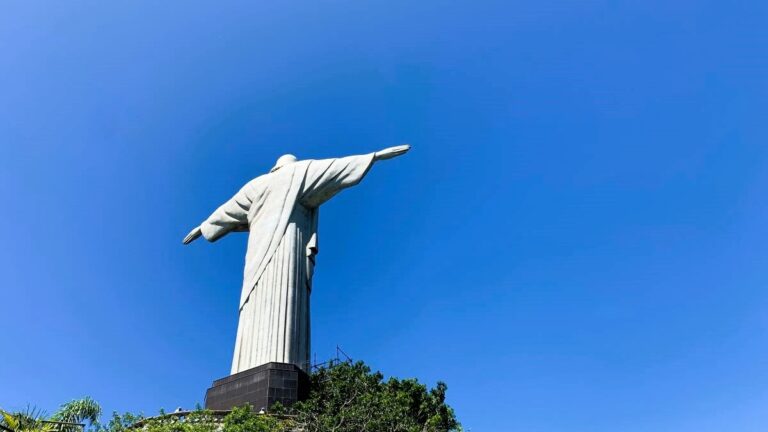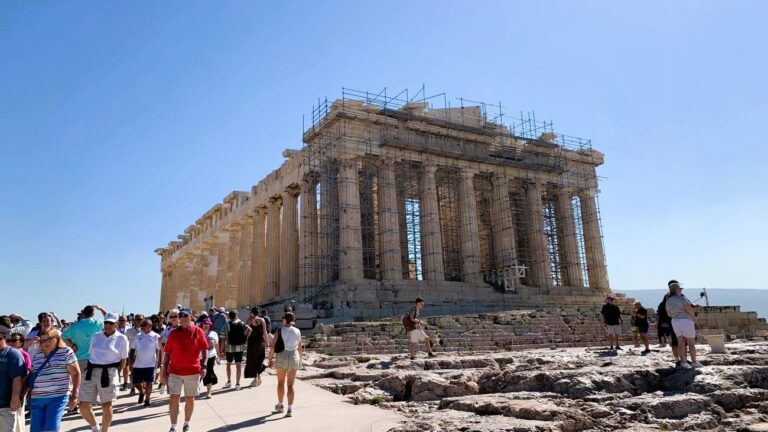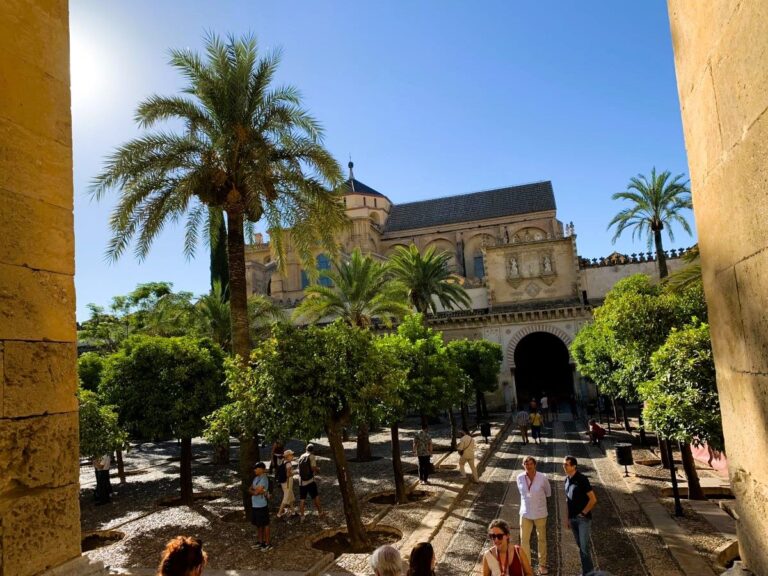Recoleta Cemetery in Buenos Aires: History, Highlights, and Visitor Tips for 2025
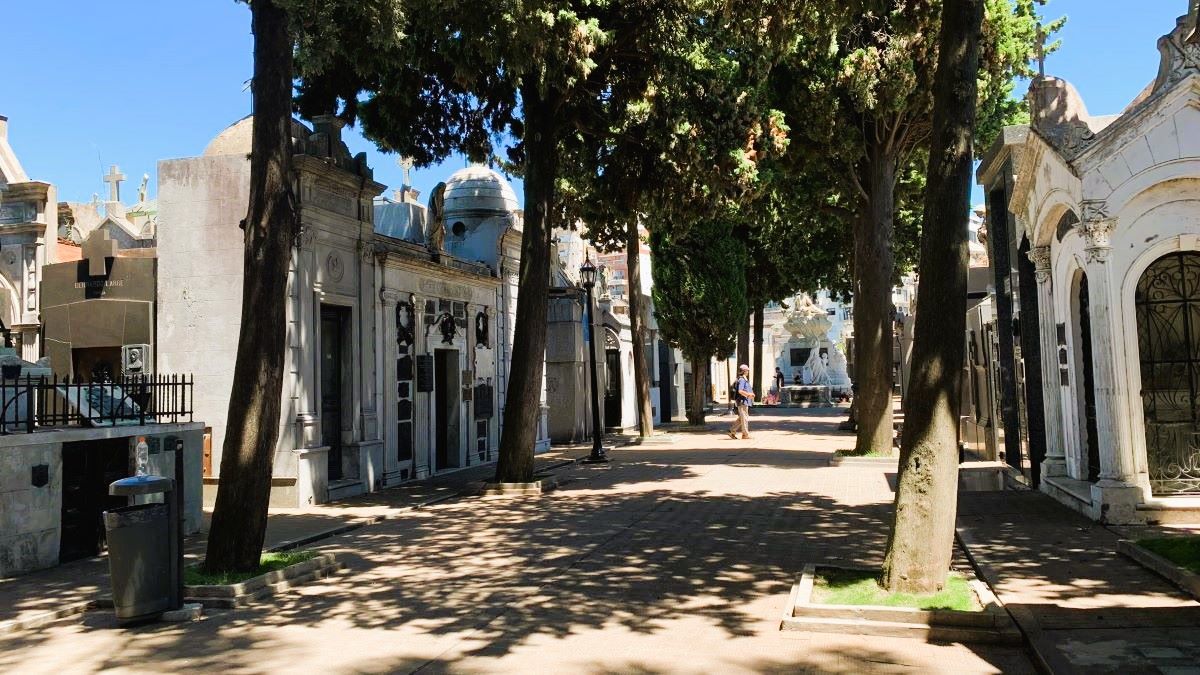
Welcome to Recoleta Cemetery!
“If you’re visiting Buenos Aires, this is a place you should see at least once. You’ll leave with photos, stories, and a deeper understanding of Argentina’s history.”
Related Posts:
Introduction: Why Visit Recoleta Cemetery?
Recoleta Cemetery in Buenos Aires is not your typical graveyard.
It’s more like an open-air museum filled with marble mausoleums, intricate sculptures, and winding paths. It must be one of the most beautiful cemeteries in the world.
You don’t have to be a history expert to enjoy it. Walking through Recoleta feels like stepping back in time. That’s really how it feels. Every turn reveals something stunning – a unique statue, or a piece of architecture that stops you in your tracks. It’s peaceful, but also full of quiet energy, with travelers, photographers, and even local cats wandering between the tombs.
If you’re visiting Buenos Aires, this is a place you should see at least once. You’ll leave with photos, stories, and a deeper understanding of Argentina’s history.
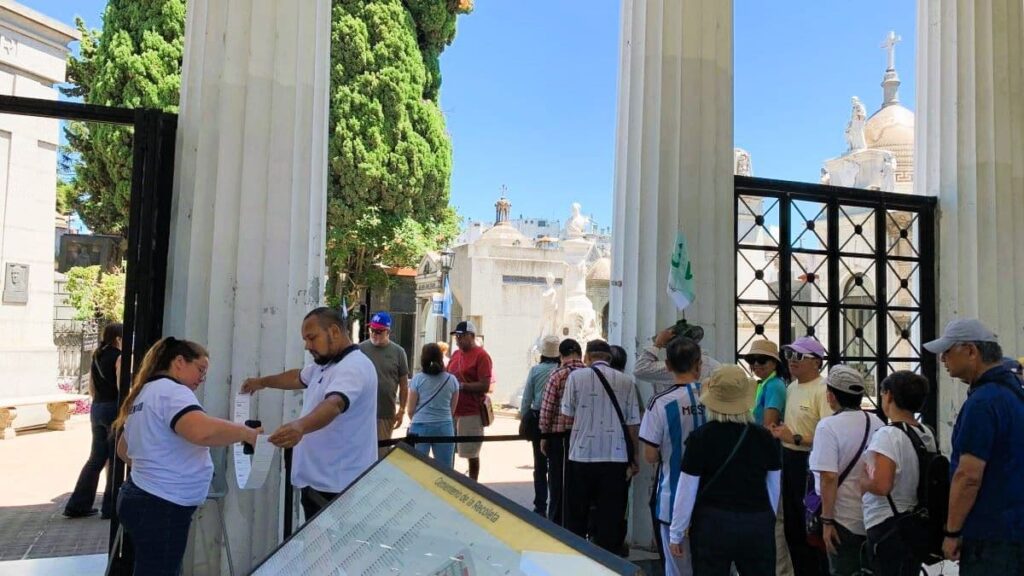
The History of Recoleta Cemetery
From Farmland to Famous Landmark
Recoleta Cemetery didn’t start as the grand place you see today. Back in the early 18th century, this land belonged to monks. They grew crops and raised animals where the cemetery now stands. In 1822, a group of city leaders decided Buenos Aires needed a proper burial ground. They opened the cemetery as the city grew, setting the stage for it to become something special.
A Resting Place for the Elite
What made Recoleta Cemetery different was who got buried there. The government set rules at first—only those from wealthy or high-ranking families could buy spots. Over time, many important people in Argentina chose to be buried here. The cemetery became a sign of respect and honor.
Did You Know?
- Recoleta Cemetery was the first public cemetery in Buenos Aires.
- The name comes from the monks called “Recoletos” who once lived nearby.
Stunning Architecture: Art Around Every Corner
Tombs Like Tiny Palaces
One thing that makes Recoleta Cemetery famous is the look of its tombs. They are not just simple stones. Many are large, decorated mausoleums that look like little houses or chapels. Walk through the gates and you’ll notice styles like Art Deco, Gothic, and Baroque. Family names carved above the doors have survived for centuries.
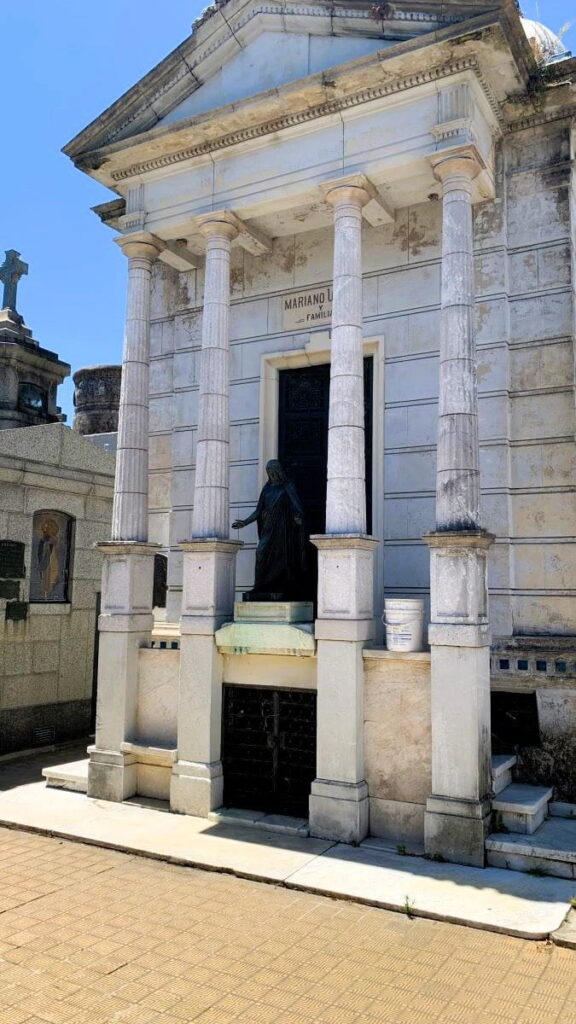
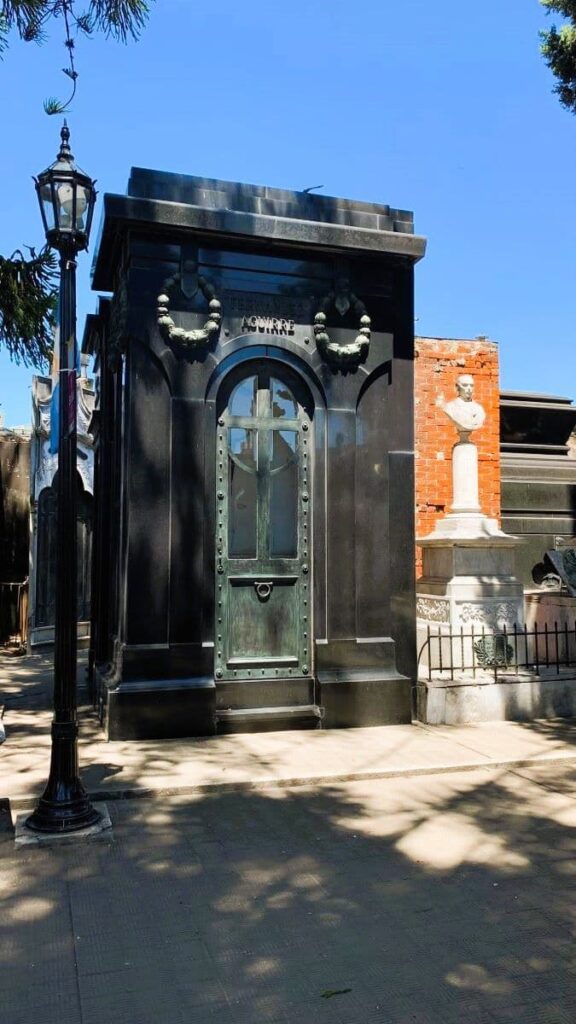
Some tombs have columns, stained glass, or fancy ironwork. You’ll see angels, weeping women, and even lions guarding the resting places. Sculptors and architects competed to make each family’s mausoleum stand out. That’s why the cemetery feels almost like a neighborhood built for the afterlife.
Stone Stories
Many tombs tell stories through their statues and drawings. Angels point to the sky, symbolizing hope. Books or bookshelves on tombs honor writers and thinkers. Some displays show soldiers or heroes from Argentina’s wars fighting bravely. If you look closely, every carving means something.
Suggestion: Next time you visit a cemetery or park, look for symbols or details in statues. What stories do you think they tell?
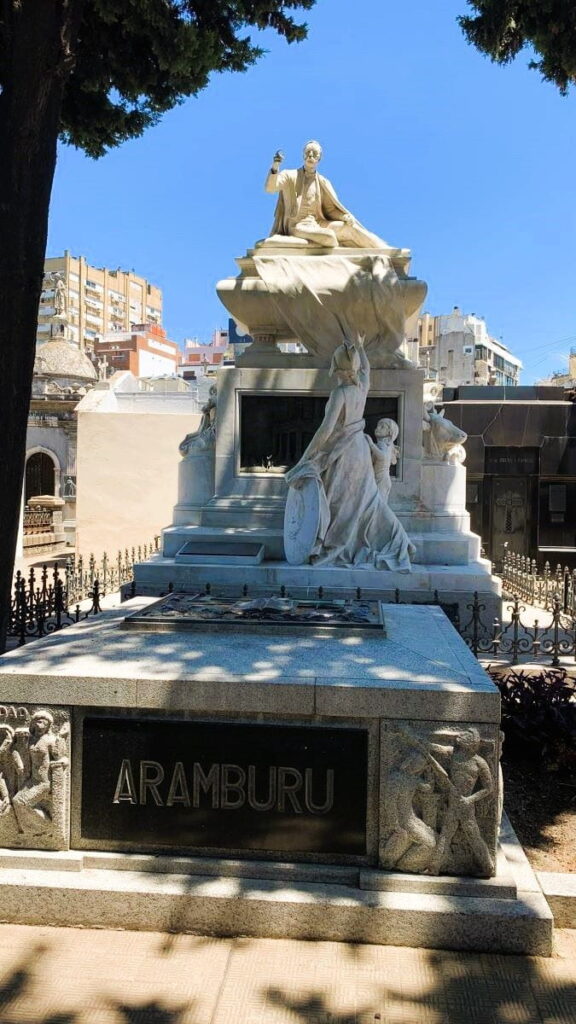
Famous People Buried in Recoleta Cemetery
The Most Visited Grave: The Tomb of Eva Perón
It’s hard not to be curious about the people buried here, especially when you see visitors crowding around certain mausoleums. The big draw is Eva Perón, or “Evita,” whose life and story shaped Argentina in huge ways.
Her tomb is simple compared to others, yet it’s almost always covered in fresh flowers, a true sign of how much she is loved by locals. You can learn more about her and other famous graves in this helpful list of the top tombs to visit at Recoleta Cemetery.
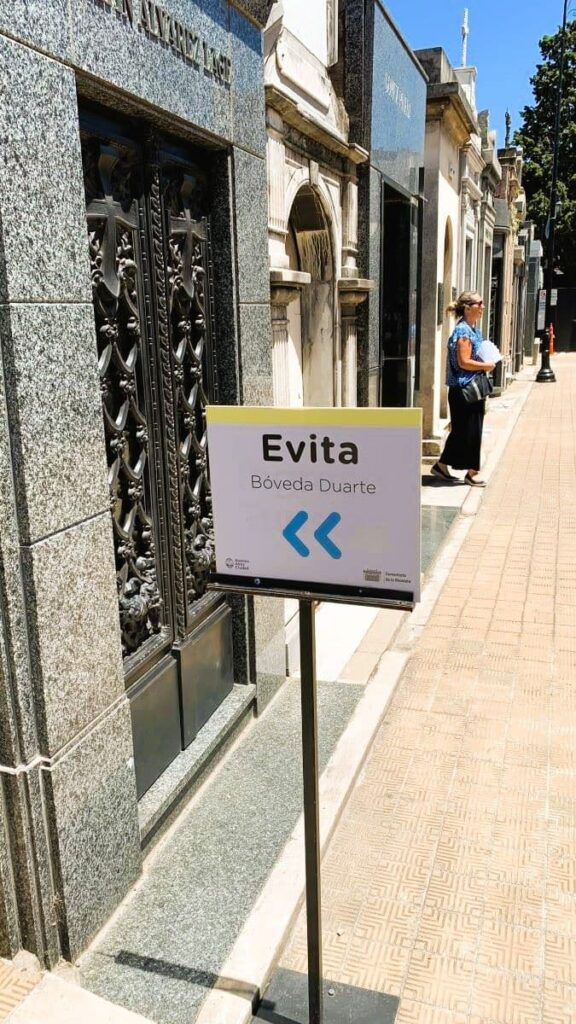

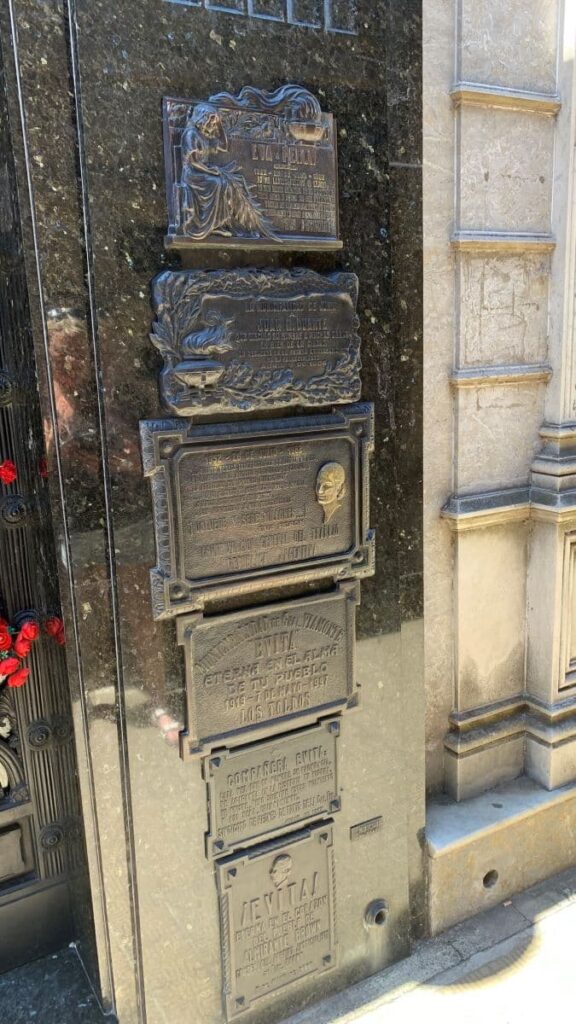
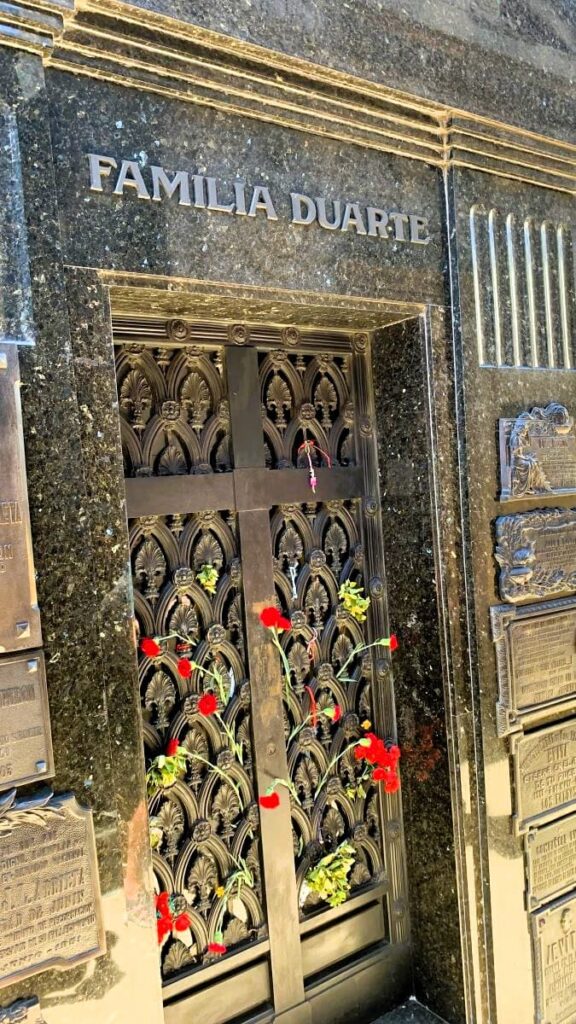
More Famous Names
- Raúl Alfonsín – Argentina’s first president after democracy returned in 1983.
- Domingo Faustino Sarmiento – A former president and key figure who helped shape Argentina’s schools.
- Admiral William Brown – Founder of the Argentine navy.
- Luis Federico Leloir – Won the Nobel Prize in Chemistry!
- Rufina Cambaceres – Known for the mysterious legend that she might have been buried alive.
Every famous grave comes with its own tale. Some stories are sad, some are inspiring. You can even join a guided tour to learn about them all.
The Story of Rufina Cambacers: The story goes that Rufina, a young woman from a wealthy family, was mistakenly thought to be dead and placed in her coffin alive. According to legend, workers later found the coffin disturbed, leading to haunting tales of her spirit wandering the cemetery. The sculpture above her tomb, showing Rufina pushing open a door, adds a dramatic touch to the legend.
Imagine if you could talk to someone buried in Recoleta Cemetery. Who would it be? What would you ask?
What to See and Expect When Visiting
Walking the Paths
Recoleta Cemetery covers over 14 acres, with over 6,400 tombs and mausoleums. It feels almost like a small city. The walkways twist and turn, and there is something to discover around every corner. Take your time. Maps at the entrance can help you find the most famous graves.
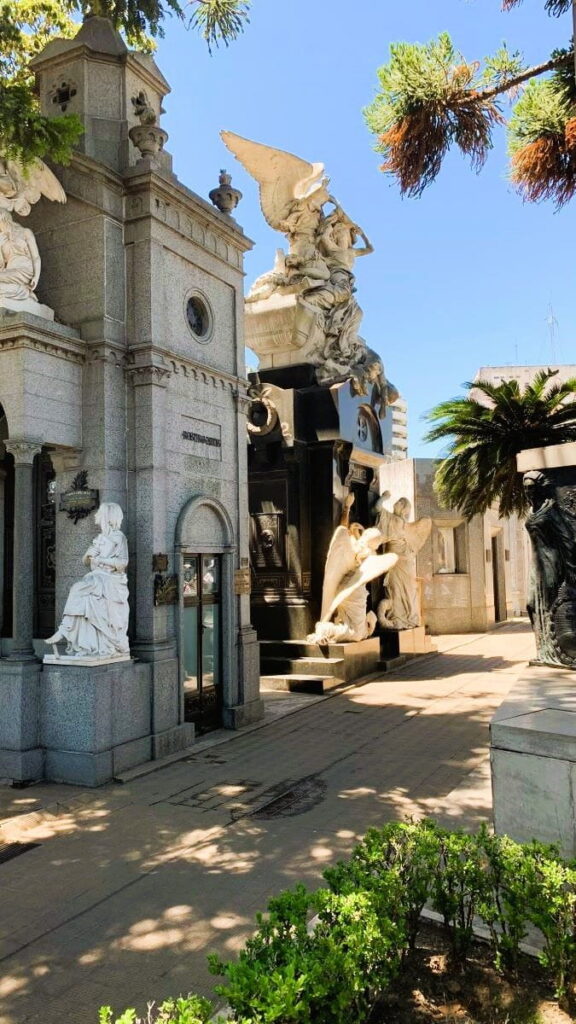
Unique Sights
- La Recoleta Church: Next to the cemetery, with beautiful white walls.
- Cats of Recoleta: Many friendly cats wander the grounds. Locals love them!
- Art and Photography: Artists and tourists come here to sketch, paint, or take photos. The way light and shadows play on the marble is eye-catching.
- Quiet Spaces: You can find a peaceful bench to sit and think, away from the city’s noise.
Tips for Visitors
- Wear comfortable shoes—the walkways are stone, and sometimes uneven.
- Take water, especially on hot days.
- Stay respectful. This is the final resting place for thousands of families.
Tip: Bring a small notepad and write down anything that surprises you during your visit. Maybe you’ll spot something most people miss!
Best Times to Visit Recoleta Cemetery
Recoleta Cemetery is open almost every day, but the best time to go is in the morning or just before sunset. The sunlight makes the marble glow and casts long shadows, giving the tombs a magical look.
Visit on a weekday if you want fewer crowds. Weekends tend to be busier, especially after lunch. If you enjoy guided tours, check the schedule ahead of time—many are offered in Spanish and English.
- Opening hours: Usually from 8:00 am to 5:00 or 6:00 pm. Sometimes hours change for holidays.
- Weather: Buenos Aires gets hot in summer. Fall and spring are cooler and great for exploring outdoors.
Ticket Information and Entry Details
Getting into Recoleta Cemetery is easy.
- Ticket price: For many years, it was free for everyone. In recent times, there’s a small fee for tourists (usually under $10 USD; prices change, so check before you go).
- Locals: Residents can often enter without paying.
- Guided tours: Some are free, and some charge a small fee. These are a good way to learn stories you’d never find on your own.
- Maps: Pick up a map at the entrance, or download one online to your phone.
Check the official Recoleta Cemetery website or the Buenos Aires tourism site for the most up-to-date info.
Guided Tours
A guided tour adds another layer to your time at Recoleta Cemetery in Buenos Aires. Guides do more than share facts—they tell stories that make the tombs come alive.
Tours are offered in English and Spanish and run most afternoons. The popular start time is 3:30 pm from Monday to Saturday, with tours lasting about two hours. Some tours focus on history, while others share local legends or architectural highlights.
If you’re interested, you can book a Recoleta Cemetery tour in advance to lock in your spot. These tours charge a fixed fee, but keep in mind that the price for entrance isn’t usually included, so you’ll still need to pay at the gate. If you want to get the full story on Argentina’s most famous cemetery, a tour is worth it.
You can also find options for private or small group tours, and some even bundle stops at other city highlights. More details about different tour styles are available through Viator’s Recoleta Cemetery listings.
Also check out Guru Tours.
Why Recoleta Cemetery is Worth Your Time
Recoleta Cemetery is a place where art, history, and legend meet. It’s a spot where you can stroll, look closely, and think deeply. Every tomb has a unique design. The energy is calm, filled with the love and effort families put into remembering those they lost.
If you like exploring, learning, or photography, this spot is perfect for you. Even if you aren’t a “cemetery person,” Recoleta will change your mind. It’s amazing to see how beauty and silence can tell you so much about people’s lives.
An interesting suggestion: After visiting, see if you can find a book or movie about someone buried there. Dive deeper into their life or era—it’s a fun way to connect your experience to Argentina’s wider story.
Connect With Other Nearby Sites
Recoleta Cemetery sits right in one of Buenos Aires’ most interesting neighborhoods. There are leafy parks, art museums, and plenty of cafés nearby. If you’re planning how to explore the city, combine your cemetery visit with lunch or a stroll through the nearby Plaza Francia.
If you want a full list of things to see in Buenos Aires beyond the cemetery, check out my roundup of best things to do in Buenos Aires.
Follow these tips and you’ll enjoy Recoleta Cemetery in Buenos Aires at your own pace, with all the practical info you need for a smooth visit.
Quick FAQ: Plan Your Visit
Where is Recoleta Cemetery?
It’s in the Recoleta neighborhood of Buenos Aires, near parks, cafes, and museums.
How much time should I plan to spend?
Most people spend one to two hours, but some stay all day exploring.
Is it safe?
Yes, it’s in a safe, busy area. As in any tourist spot, keep an eye on your stuff.
Can I take photos?
Yes! Just be respectful and avoid disturbing ceremonies.
Final Thoughts
Recoleta Cemetery is more than a tourist attraction. It’s a place where Argentina’s history, art, and personal stories meet. Every corner reveals something worth pausing for — a sculpture, a name, a symbol from another era.
It’s not a gloomy place. But it’s easy to feel a wave of sadness here when you stop and think about who’s buried here. Many of the people buried in Recoleta once lived lives of incredible wealth and influence. Some shaped Argentina’s history, leaving behind legacies that still echo today. Yet now, all of them rest in the same quiet stillness, their voices silent, their stories told only through stone and marble.
Walking among these grand mausoleums is a reminder that time humbles everyone — and that beauty, memory, and history can live on long after we’re gone.
So if you’re planning a trip to Buenos Aires, put Recoleta Cemetery on your list. Bring your camera, an open mind, and a little curiosity about the lives of those who came before you.
If you want a full list of things to see in Buenos Aires beyond the cemetery, check out my roundup of the best things to do in Buenos Aires.
Recent Posts:
-
The Best Florence 3-Day Itinerary For First Timers (Landmarks, Views, And Food)
Planning a trip to Florence? Awesome! You’re in for a treat! Florence packs centuries of art, culture, and history into streets that are super easy to wander on foot. This Florence 3 day itinerary is built for first-time visitors who want the big sights, plus time to eat well, shop a little, and wander without…
-
Your Ultimate 3-Day Itinerary in Rome (First-Time Visit Guide)
Arriving in Rome, the Eternal City, for the first time feels like stepping into a living history book. I’m not kidding. Everywhere you turn you find ancient ruins, renaissance churches, and fountains, sometimes sharing the same charming streets. The city buzzes with energy, from the scooters zipping by to the lively piazzas filled with people…
-
The Ultimate Italy Travel Guide for First‑Time Visitors (Simple, Honest Tips)
Italy is one of those places that lives in your head long before you land. Ancient ruins, quiet churches, busy piazzas, long dinners, and trains that carry you from city to city like scenes in a film. When friends ask me where they should go on their first big trip to Europe, Italy is usually…
-
Travel Chiang Mai, Thailand: A Calm Base for Temples, Markets, and Food
Your Ultimate Travel Chiang Mai Thailand Guide Chiang Mai sits in a green valley in northern Thailand, ringed by low mountains and crowned by temples that have been there for centuries. Key Takeaways: This Travel Guide to Chiang Mai, Thailand also shares a simple 3-day plan you can follow without stress. The Old City, with…
-
Lake Bled Day Trip: The Perfect First-Time Adventure from Ljubljana
Welcome! If you’re spending time in Ljubljana and want to experience Slovenia’s most magical landscapes, a Lake Bled day trip from Ljubljana is an easy choice. With its glacial blue water, Lake Bled Island at its center, and Bled Castle perched high on the cliffs, this spot looks straight out of a fairytale—no need for…
-
Best Things to Do in Ljubljana, Slovenia (First-Time Visitor’s Guide)
Welcome! Thank you for visiting my blog about the best things to do in Ljubljana! In this guide I’ll share my own favorite spots and handy tips, best places to eat and some local insights you might not find elsewhere. Ljubljana, the charming capital of Slovenia, is stunning! The architecture is breathtaking! I promise you,…

